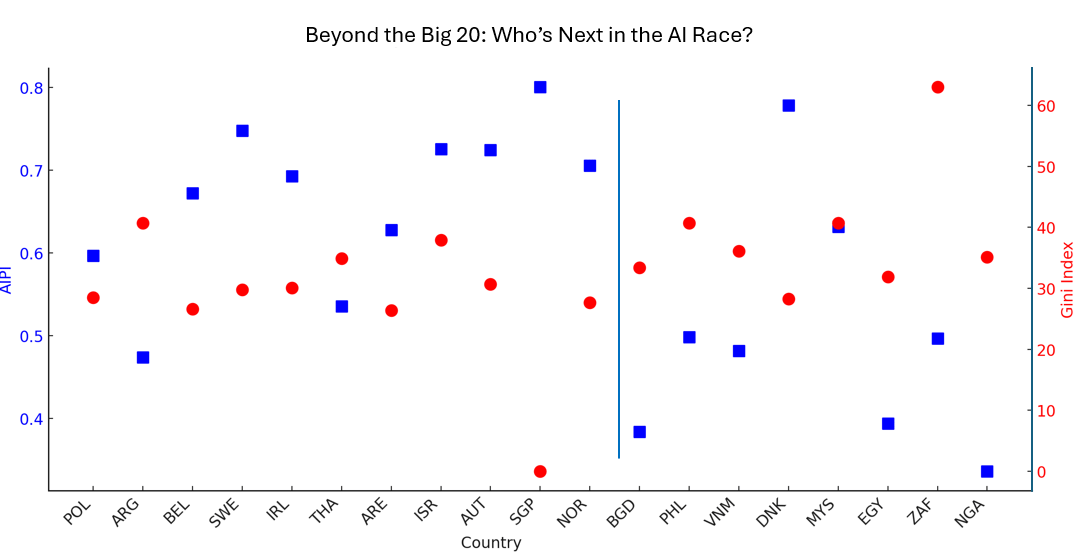AI is transforming the future—fast. Who’s truly ready for it, and who risks leaving people behind? Part II
Compared to the Top 20 GDP countries, where digital infrastructure is generally more mature, In part 2 of our series, we take a similar look at the Next 20 group. Let's Dive In.
4/17/20252 min read


This dual-axis plot compares the AI Preparedness Index (AIPI) and Gini Index (income inequality) for the 20 largest economies in the world.
AIPI (blue squares, left Y-axis): Higher = more ready for AI adoption and integration
Gini Index (red circles, right Y-axis): Higher = more income inequality
What the data tells us, a summary
When we examined the world’s top 20 countries by GDP, AI preparedness (measured by the IMF’s AI Preparedness Index) and income equality (measured by the Gini IndexGini Coefficient), the picture was mixed. Countries like Germany and Japan combine strong AI readiness with relatively low inequality, while the United States and Brazil show high or moderate AI preparedness alongside notable disparities in income.
But what about the next 20 countries by GDP—those ranked 21 through 41? This group represents a diverse mix of emerging markets and regionally influential economies. When we apply the same lens—comparing AIPI to Gini scores—a new and fascinating pattern emerges especially countries after Norway.
Several countries in this cohort display low AIPI scores coupled with lower income inequality. This suggests that while these countries may not yet have the digital infrastructure, human capital, or innovation ecosystems to adopt AI at scale, they maintain a more equitable distribution of wealth. Countries like Poland (POL) and Malaysia (MYS) fall into this category, highlighting a relatively balanced socioeconomic structure despite more modest AI readiness.
On the other end of the spectrum, nations like Russia (RUS) and South Africa (ZAF) show moderate to low AI preparedness but very high Gini scores, pointing to deep-rooted inequality that could be further strained by rapid AI integration.
Perhaps most compelling is Singapore (SGP)—a standout in the group—with very high AIPI and remarkably low income inequality. Singapore demonstrates that it is not only digitally mature and well-positioned to adopt AI, but also maintains a tightly managed, equitable economic model.
Compared to the top 20 GDP countries, the “Next 20” group shows greater variation. While some approach top-tier AI readiness, others are still building foundational capabilities. At the same time, this group tends to skew toward lower inequality overall, suggesting that these countries may have an opportunity to build AI infrastructure with inclusion in mind from the start.
This contrast underscores a valuable insight: Economic size doesn’t dictate technological readiness or fairness. As this next tier steps up in the global AI race, the opportunity lies not just in catching up—but in doing so more equitably.
Interested in a further deep dive or want access to the formatted data set ? contactus@btrackdata.com
AI Preparedness Index IMF - https://www.imf.org/external/datamapper/datasets/AIPI
GINI Index sourced from World Bank - https://data.worldbank.org/indicator/SI.POV.GINI
